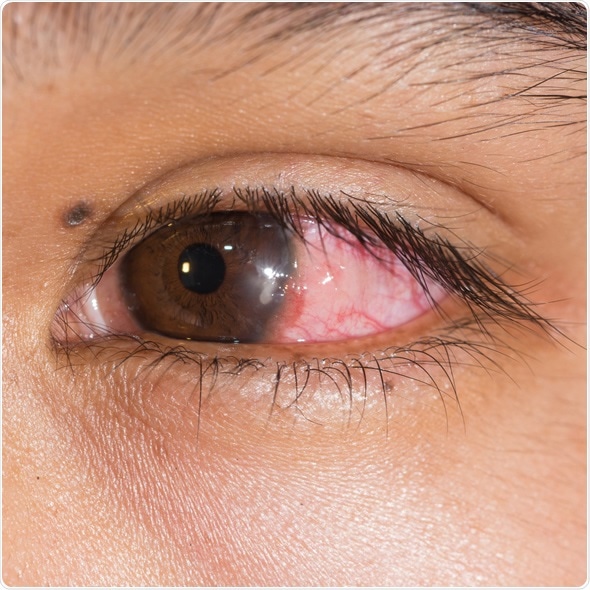Bacterial keratitis is a condition that involves an infection of the cornea. This is the clear dome that covers the iris and pupil of the eye. Bacterial infection of the cornea can lead to symptoms such as pain, photosensitivity, discharge from the eye, and impaired vision.
In the United States, approximately 25,000 people develop bacterial keratitis each year. The incidence throughout the world is variable, but it is more common in developed countries due to the significantly higher number of people who use contact lenses, which increases the risk of the condition.

Close up of the infected bacterial corneal ulcer during eye examination. Image Copyright: ARZTSAMUI / Shutterstock
Types
There are two types of bacterial keratitis, according to the area of the cornea that is affected by the infection.
- Superficial keratitis affects the outer layers of the cornea and usually heals without leaving a scar.
- Deep keratitis affects the deeper layers of the cornea and may leave a scar after healing. This can sometimes permanently affect vision.
Development
Bacterial keratitis tends to develop quite quickly and requires timely treatment to reduce permanent damage to the eye. In severe cases without adequate treatment, bacterial keratitis has the potential to cause blindness. Virulent bacteria may cause complete destruction of the cornea within 24-48 hours.
Characteristic signs of bacterial keratitis include:
- Corneal ulceration
- Stromal abscess formation
- Corneal edema
- Anterior segment inflammation
Affected individuals may have red and inflamed eyes that cause significant pain. They may also find that they are more sensitive to light than usual, with excessive production of tears or other discharge. Blurred vision is another common symptom of bacterial keratitis.
Causes
There are two types of bacteria that most commonly cause bacterial keratitis: Staphylococcus aureus and Pseudomonas aeruginosa. A break in the corneal epithelium or tear film allows the causative microorganism to enter the corneal stroma, where they may cause an infection.
People who wear contact lenses are much more likely to be affected by bacterial keratitis than other individuals, although anyone can be affected.
Other risk factors include:
- Recent injury to the eye
- Recent refractive corneal surgery
- Weak immune system
- Abnormal eyelids
- Abnormal tearing
- Other eye diseases
Recommendations for Contact Lens Users
As individuals who wear contact lenses are at a significantly higher risk of bacterial keratitis, it is important that they are aware of things they can do to protect themselves from the infection. This may include:
- Avoiding wearing contact lenses overnight
- Disinfecting contact lenses as required
- Cleaning the contact lens cases as required
- Avoiding storing or rinsing contact lenses in water
- Using a clean lens solution each day
- Avoiding shared use of contact lenses
Management
An ophthalmologist will usually confirm the diagnosis of bacterial keratitis by testing a sample of material scraped from the eye.
Antibiotic eye drops are typically used to manage the bacteria infection, sometimes along with a topical steroid medication. Eye drops usually require frequent administration to control the infection.
A follow-up appointment with the ophthalmologist is commonly required to monitor the condition and ensure the infection is managed appropriately.
Related Conditions
There are also other types of keratitis that are not caused by a bacterial infection. These include:
- Amoebic keratitis
- Fungal keratitis
- Viral keratitis
- Photokeratitis
References
Further Reading